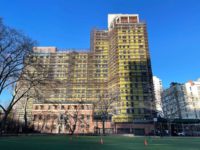During the design phase of almost any architectural building, aesthetics is the top priority. When considerations for assembly and installation were addressed with the Arizona Center for Law and Society, practicality and innovation by Kovach Building Enclosures made it all work.
Construction of the new and quite unique facility in Phoenix presented a bevy of challenges concerning the design and installation of the building’s multi-material façade. The owner and general contractor wanted a building clad with a local stone façade that was not only code compliant and fully warrantied, but would also be durable enough to last a century. In addition, the schedule was extremely aggressive and the downtown location presented logistical challenges.
Based on experience with architectural cladding and unitized glass systems, Kovach believed a traditional stone system was not a viable option, given the compressed timeframe and crowded jobsite. At this point many contracting firms might admit this type of project would be biting off more than they wanted to chew. The challenge of constructing a 100-year building on a tight schedule demands incredible coordination and delivering a finished product that would satisfy the design team as well as the school would no doubt be a massive undertaking.
Kovach refers to these challenges as “disruptive innovation.” After a thorough evaluation of the project, Kovach went to the drawing board determined to, “build a better mousetrap.” In this instance, the Kovach team believed the solution was to unitize the façade system.
With the go-ahead from the general contractor, Kovach designed a unitized façade system that directly addressed those challenges and satisfied the design team’s questions; in this case designing and engineering a wall panel system that married several products covered by a single watertightness warranty, while meeting all code requirements and allowing design freedom.
“Like any project, there were challenges and the first one is always the same: we were on a fairly aggressive schedule,” says James Hatch, Preconstruction Manager at Kovach. “We’re used to that, but never let quality or safety suffer because of a time crunch.”
The design team specified a traditional wall assembly that incorporated local stone, architectural fins and glazing. Normally, that requires several different tradesmen to complete the install. Stud framers would be followed by someone to do sheeting and waterproofing. A mason and a glazer would finish the enclosure. That takes lot of safety equipment and coordination by the general contractor to make it happen. That all takes up valuable time, a luxury not afforded to the general contractor on this project. Unitizing the façade allowed for the elimination of four trades to help keep the project on schedule.
“We designed the exterior shell and Kovach provided suggestions and a system that made it work,” says Greg Clawson, AIA, LEED BD+C, senior associate at Ennead Architects LLP in New York. “The unitized system simplified construction and saved a lot of time.”
Because the system was fabricated and assembled at the Kovach shop, the installation was safer and required a smaller crew and a smaller staging area. The eight to 12-man crew onsite was able to crane from the ground directly to the building, virtually eliminating the need for scaffolding. This not only greatly reduced the risk of injury on the jobsite and maximized man power, but it provided much needed space for the congested jobsite.
The System
The weight and attachment methods of traditional 2-1/4-inch thick stone would prevent the system from being unitized. The first challenge was to eliminate some weight by using a thinner stone, but it couldn’t be any stone. To satisfy the design intentions of the school, it had to be sourced from an Arizona quarry. The project was able to source a local quarry that operated a saw capable of cutting stone down to 1-inch thick. Eliminating 60 percent of the weight ultimately led to the successful design of a unitized the system. (The thinner stone was also less expensive, a fortunate benefit of the innovative system.)
Since a traditional kerf attachment method could not be used on the thinner stone, Kovach engineered a frame that attached to the mullions. A concealed anchor system secured the 1-inch stone to the frame, per code requirements. Hatch says a worldwide search of concealed anchor systems led Kovach to Europe, where a system was in use that did not create compression points that could crack the stone.
With the stone challenges answered, the next challenge was designing a system that would meet thermal, fire and waterproofing code requirements. Kovach was able to employ an already-tested insulated metal panel into the glazing frames of a unitized curtainwall system as part of its new stone system. The insulated metal panel eliminated the need for waterproof, fire, sheathing and insulation testing. As a bonus, the aluminum skin will not break down under UV, allowing the stone to have 1/8-inch joints that do not require grouting.
The end result is a stone rainscreen, where the waterproofing is handled behind the stone. The stone framing bracket was designed to allow for varying angles of installation. All of the glazing was installed on the same plane, while the stone could be designed in a saw tooth pattern. The male-female joinery of the unitized panels allowed the designer the freedom to alternate between slot glass and stone panels, as well as incorporate architectural fins on the East and West elevations of the building. The fins, fabricated using Kovabond (Kovach’s proprietary ACM line), not only provide critical shade from the sweltering Arizona sun but also contribute to the building’s striking façade.
“It looks terrific, everyone that has seen it is happy with the way it looks,” Clawson says. “The angled stone does two things. It provides solar control and it gives a variation to the surface of the building.”
The school raised question of durability. Using a stone that was only 1-inch thick in a system than had not been used before … would it last a minimum of the targeted 100 years? “We were able to do independent third-party testing on the entire system,” Hatch says, satisfying all concerned.
In addition to the standard strength and rupture tests (ASTM C1751, C97, C99, C170, and C1352) required for stone facades, the system also underwent an accelerated weathering test. “ASTM C 880 is a flexural strength loss test that simulates how the stone’s strength will be affected over time. These test results were critical to providing the owner with assurance that our system was sure to perform for a minimum of 100 years,” says Hatch.
Safety/Quality
All of the assembly of the wall panels was done in a conditioned shop, where crews were not working in 110 degree heat on scaffolding high above the ground. Each panel was laying horizontally at an ideal working height, allowing extraordinary safety and quality control. Each panel had a 60-point checklist to ensure all components were fabricated to spec.
“This is the ultimate in quality control,” Hatch says. “Working safely to assemble the panels at comfortable levels and both feet on the ground ensures a top quality system. It’s a lot more relaxed working under these conditions. We’re always in favor of that.”







